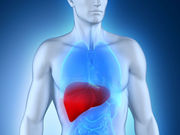Similar reduction in serum endotoxin level for low-dose, high-dose rifaximin
THURSDAY, Oct. 29, 2015 (HealthDay News) — For patients with liver cirrhosis, low-dose rifaximin is comparable to high-dose rifaximin for reducing serum endotoxin levels, according to a study published online Oct. 16 in the Journal of Digestive Diseases.
Xin Zeng, from the Second Military Medical University in Shanghai, and colleagues examined the efficacy, safety, and tolerability of different rifaximin doses in patients with hepatic cirrhosis. Sixty Chinese patients with liver cirrhosis underwent screening and 43 were eligible for inclusion. Patients were randomized in a 1:1:1 ratio to low-dose rifaximin (400 mg two times/day), high-dose rifaximin (600 mg two times/day), or control. The treatment period was two weeks and the observation phase was four weeks.
The researchers found that the serum level of endotoxin was significantly lower in the low-dose rifaximin group and high-dose rifaximin group compared with the control group (1.1 ± 0.8 and 1.0 ± 0.8, respectively, versus 2.5 ± 1.8 EU/ml) after two weeks of treatment; there was no difference between the treatment groups. The high-dose rifaximin effect on endotoxemia lasted four weeks or more following drug withdrawal. After two weeks of rifaximin therapy there was a significant reduction in the abundance of the taxa Veillonellaceae and an increase in the abundance of Bacteroides. The three groups had similar incidence of adverse events and serious adverse events.
“Our findings indicated low-dose (800 mg/day) rifaximin could be analogous to high-dose (1,200 mg/day) rifaximin to reduce the serum endotoxin level after two weeks [of] treatment,” the authors write.
Copyright © 2015 HealthDay. All rights reserved.








